Food advertising – are you being manipulated? July newsletter
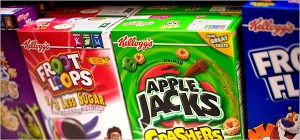 I think quite a few of you caught BBC2’s The Men That Made Us Fat and Channel 4’s Dispatches – The Myths about your 5 a Day. Both programmes highlighted exactly what is wrong with the food industry, who has the power and how we as consumers are manipulated by advertising and marketing. This month I’d like to discuss this in a little more detail and also what we can do about it. Sadly being in a double dip recession doesn’t help our food choices, and many families are going back to cheap processed food. I know its my job to advise you, but your health is paramount and good food needs to come as top priority in the budgeting! Many of you who read this newsletter are very well informed with what’s good and whats not, but you are a small minority of the population! Unless you take the time to read every ingredient on the label you cannot assume anything! So if you have any friends who you think could do we learning a thing or too, perhaps subtly forward on this newsletter!
I think quite a few of you caught BBC2’s The Men That Made Us Fat and Channel 4’s Dispatches – The Myths about your 5 a Day. Both programmes highlighted exactly what is wrong with the food industry, who has the power and how we as consumers are manipulated by advertising and marketing. This month I’d like to discuss this in a little more detail and also what we can do about it. Sadly being in a double dip recession doesn’t help our food choices, and many families are going back to cheap processed food. I know its my job to advise you, but your health is paramount and good food needs to come as top priority in the budgeting! Many of you who read this newsletter are very well informed with what’s good and whats not, but you are a small minority of the population! Unless you take the time to read every ingredient on the label you cannot assume anything! So if you have any friends who you think could do we learning a thing or too, perhaps subtly forward on this newsletter!
Advertising for kids
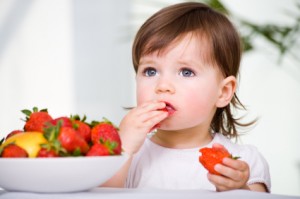 Cereals manufactured for children have allegedly become more nutritious in the last few years, however it is often the least nutritious cereal that runs the most advertising. If we take the US as an example (the numbers are far greater and more alarming over there) – according to a study by Yale Rudd Centre for Food Policy and Obesity, cereal companies spend $264 million on advertising for children annually – that’s a 34% increase from 2008 and the advertising is for, guess what.. the least nutritious cereal. If we look at the brand leaders over here they are full of sugar or the cheaper sweetener – corn syrup. Its rare to see plain porridge oats marketed but very common to see Cheerios and Coco Pops. When was it ok for kids to go to school on sugar, but is it any wonder that they do particularly with pester power and the convenience of packaged food?
Cereals manufactured for children have allegedly become more nutritious in the last few years, however it is often the least nutritious cereal that runs the most advertising. If we take the US as an example (the numbers are far greater and more alarming over there) – according to a study by Yale Rudd Centre for Food Policy and Obesity, cereal companies spend $264 million on advertising for children annually – that’s a 34% increase from 2008 and the advertising is for, guess what.. the least nutritious cereal. If we look at the brand leaders over here they are full of sugar or the cheaper sweetener – corn syrup. Its rare to see plain porridge oats marketed but very common to see Cheerios and Coco Pops. When was it ok for kids to go to school on sugar, but is it any wonder that they do particularly with pester power and the convenience of packaged food?
Walt Disney have acknowledged at last the powerful role that television can play in influencing children’s behaviour and announced that they have instituted a junk-food advertising ban on programmes for kids. The Campaign for a Commercial-Free Childhood, a US non-profit advocacy group, applauded Disney’s announcement but questioned the three-year delay until the stricter rules take full effect. In my mind, it’s just too little too late, the horse has already bolted. Today’s children consume multiple types of media (often simultaneously) and spend more time (44.5 hours per week) in front of computer, television, and game screens than any other activity in their lives except sleeping. Research has found strong associations between increases in advertising for non-nutritious foods and rates of childhood obesity.
Most children under 6 yrs old cannot distinguish between programming and advertising and children under 8 yrs do not understand the persuasive intent of advertising. Advertising directed at children this young is by its very nature exploitative. Children have a remarkable ability to recall content from the ads to which they have been exposed. Product preference has been shown to occur with as little as a single commercial exposure and to strengthen with repeated exposures. Product preferences affect children’s product purchase requests and these requests influence parents’ purchasing decisions – there’s that pester power again! To try and limit exposure is difficult and I’m not here to tell you how to bring up your children, but certainly less hours in front of the television and starting early on healthy food can help. Getting children involved in cooking and often growing food as well can educate them for the future. The power of the cereal packet is immense and market leaders with exciting toys inside the packet stand like a Collossus over the humble porridge oat – its a David vrs.Goliath task to rise above this but you can do it with a little creative input and discipline! So what about adults?
Do you buy what’s there?
When I take people shopping, three main issues come up within several of the supermarkets: the lack of stock or variety of decent bread, cereal and non alcoholic drinks. The other week I was shopping with a client in one of the major supermarkets and the soft drinks aisle was about 98% full of sugar free/high energy drinks full of corn syrup and artificial sweeteners with about 2% dedicated to cordials/organics etc. This same supermarket had the whole bread aisle full of the two main brand leaders which to my mind does not even pass as a real loaf of bread. The cereal aisle was much the same – anything organic and not full of sugar was certainly less obvious or on the bottom shelf. What happens if this is your only nearby supermarket – are you then forced into buying produce you don’t want unless you drive out of town? Do you have the time to do this? Does it matter that much to you?
Food advertising is big business and its getting more clever. The countless food advertising tricks that are used to persuade us to buy their products is disturbing. Food manufacturers are pushing the limits of what is truth and what is a simple technicality. So many packaged foods are little more than white flour, fat, sugar, salt and additives in various combinations, yet they are marketed as modern-day medical miracles, offering vague benefits for virtually every part of the body.
Marketing claims and tricks
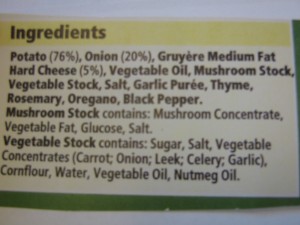 Reduced sugar is still a hook for many people purchasing foods that they think will be more healthy for them. However reduced sugar is replaced by a range of artificial sweeteners. Whole grain is another minefield – particularly if there is more whole grain than any other ingredient – it still may contain corn syrup, artificial sweeteners etc. You are being marketed a healthy product when in fact its anything but that. I recently saw a fizzy drink can with includes Antioxidants as if that made the drink healthy – trust me any antioxidants that might be present would be negated by the rest of the ingredients. I’ve seen cereal brands saying heart healthy (what does that even mean?!) or good for weight control but the ingredients tell me something different – is it any wonder why people fail to lose weight? The other huge bugbear I have is the under 100 calorie snack bar – you eat it because you think it will not make you fat because you have bought into the calorie myth but again the truth lies at the back of the packet where the hydrogenated fat or the artificial additives lie. Much of this is common sense and yet I see even the most switched on mums and dads get caught out.
Reduced sugar is still a hook for many people purchasing foods that they think will be more healthy for them. However reduced sugar is replaced by a range of artificial sweeteners. Whole grain is another minefield – particularly if there is more whole grain than any other ingredient – it still may contain corn syrup, artificial sweeteners etc. You are being marketed a healthy product when in fact its anything but that. I recently saw a fizzy drink can with includes Antioxidants as if that made the drink healthy – trust me any antioxidants that might be present would be negated by the rest of the ingredients. I’ve seen cereal brands saying heart healthy (what does that even mean?!) or good for weight control but the ingredients tell me something different – is it any wonder why people fail to lose weight? The other huge bugbear I have is the under 100 calorie snack bar – you eat it because you think it will not make you fat because you have bought into the calorie myth but again the truth lies at the back of the packet where the hydrogenated fat or the artificial additives lie. Much of this is common sense and yet I see even the most switched on mums and dads get caught out.
If I asked all of you now how much protein, salt, fat and carbohydrate you need daily – do you know? I suspect most of you don’t carry those figures in your head and that is why looking at the ingredients is the best bet you have when you shop. You are consumers not dieticians and nutritionists – its not your job to carry those figures around!
Quick tips for buying bread, cereal, and soft drinks
Bread:
If it has a non see through plastic wrapper on it and you cant see the bread, don’t buy it. If its heavily marketed on TV don’t buy it. Go for own brand wholemeal bread that you have an ingredient list to read. Organic breads, artisan breads, soda breads, rye breads, pita breads etc might not be so easily found in some of the major supermarkets, but they are getting better. Don’t assume that baked on the premises bread is any better – again – where’s the ingredient list?
Cereal:
To be honest, no cereal is all its cracked up to be except plain 100% oats or a puffed rice brand with no sugar. Unless its got one ingredient its more than likely got sugar as the first ingredient or the delightful addition of glucose syrup or corn syrup. So yes that’s 95% of the supermarket aisle gone before you’ve started! The odd packet of Dorset organic cereal/granola etc is fine but don’t forget its still sugary with dried fruits and honey! Better to stir a spoonful into yoghurt or try and add more nuts!
 Soft Drinks:
Soft Drinks:
Go for cordials – try Rocks, Belvoir, Firefly, or 100% non concentrated juice. Avoid all sugar free/reduced sugar drinks. You may notice that the soft drinks aisle is full to bursting with all the drinks I haven’t listed and there will be a small portion of the aisle with a few bottle of the above. If you want more choice, quite frankly I’d go to Waitrose and check out their great range of non alcoholic drinks! And remember fructose is sugar – and fruit juice is concentrated sugar – keep it to a minimum!
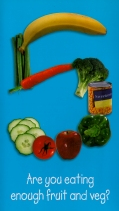 How important is your 5 a day?
How important is your 5 a day?
Did you think five a day was a global campaign – that all countries needed to eat five portions of fruit and vegetables a day? Well if you did, you’d be wrong! In actual fact it’s a different number for every country campaign. The USA is 9 portions, two and half cups of fruit and vegetables per day. Australia is 5 but the portion is 75g. Denmark, 6, Ireland is 4, Switzerland, 5, as is Belgium and Austria. Italy… well they are very laid back with their advice to eat more fruit and vegetables – no exact number! Ah now wonderful Greece – they recommend 3 portions of fruit and 6 of vegetable – so sensible. Germany looks pretty cool with 3 portions and their food pyramid has more emphasis on vegetables than fruit. This 5 a day programme started in 1991 as The National Five a Day For Better Health Programme. It was a public-private partnership between the Produce for Better Health Foundation and the National Cancer Institute and it started in sunny California. It has since become the worlds largest education initiative. So far so good. However there is a conflict of interest as The Producers For Better Health Foundation whose purpose is to get us to eat more fruit and vegetables are sponsored by these folk!:
Logistics firms: C.H. Robinson Worldwide, Inc.; Caito Foods, Inc.; Capital City Fruit; Coast Produce Company and J&J Distributing.
Specialist producers: Driscoll’s (berries); U.S. Highbush Blueberry Council (blueberries); Ocean Mist (artichokes and fresh vegetables); Giorgio (mushrooms); Columbine Vineyards (grapes); Nature sweet tomatoes; Potandon Produce (potatoes) and Paramount Farms (nuts and flavoured nut snacks).
General fresh produce firms: W. Newell & Companies; Eurofresh Farms; Giumarra Companies; General Mills (Green Giant brand); Sun-Maid raisins and dried fruit; Kagome juices and Duda Farm Fresh Foods;
Other: such as BASF (the world’s leading chemical company, and a provider of fungicides, insecticides and herbicides); Glad Products Company (containers, bags and ovenware); Nunhems USA (commercial vegetable seeds);
Excuse the cynicism but one could say that these companies stand to benefit if the government dictated the five a day campaign. While there is nothing wrong with tomatoes being sponsored, there is still a conflict of interest with the above companies.
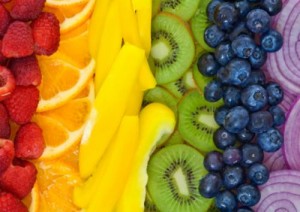 So why 5 a day? Well it certainly did not come from evidence based scientific investigation! In essence its easy to remember and it is a marketing campaign and the most successful the world has ever seen. With little or no evidence at this time of any benefit from eating exactly 5 portions of fruit and vegetables a day, it is astonishing to look at how far this marketing campaign has gone. Questions that need to be asked are what has it achieved? Has it worked? What was its aim in the first place? The campaign has since been reviewed. Between 1991 and 1998 the figure of Americans who knew to eat 5 portions of fruit and vegetables a day rose from 8% to 39% – so that’s a good thing right? Well, at the same time the obesity figures rose from 12% to 17.9%. It’s all a bit nonsensical and then of course for those of you who saw the Dispatches programme – The Myths about your 5 a day – a made up magical number was then taken by marketing and advertising companies and twisted even more into the fabric of what we eat. It’s exhausting isn’t it!
So why 5 a day? Well it certainly did not come from evidence based scientific investigation! In essence its easy to remember and it is a marketing campaign and the most successful the world has ever seen. With little or no evidence at this time of any benefit from eating exactly 5 portions of fruit and vegetables a day, it is astonishing to look at how far this marketing campaign has gone. Questions that need to be asked are what has it achieved? Has it worked? What was its aim in the first place? The campaign has since been reviewed. Between 1991 and 1998 the figure of Americans who knew to eat 5 portions of fruit and vegetables a day rose from 8% to 39% – so that’s a good thing right? Well, at the same time the obesity figures rose from 12% to 17.9%. It’s all a bit nonsensical and then of course for those of you who saw the Dispatches programme – The Myths about your 5 a day – a made up magical number was then taken by marketing and advertising companies and twisted even more into the fabric of what we eat. It’s exhausting isn’t it!
Added to the already mind boggling food labelling – shopping, food advertising and food marketing is big business. We need to simplify the whole thing and fast. The only part of dietetics I don’t like is the fixation of looking at the front of the packets of food with the wheels and fat/protein breakdown. We need to look at the ingredients list, we need to know what manufacturers are putting into food not just the fat content. So always look at the ingredients on the back of the packet – you will find out very quickly whether this product is worth buying. As I’ve said before fast food outlets don’t let you easily see the full list of ingredients in their products – perhaps because you wouldn’t buy them if you really knew. I’m more concerned at the hideous ingredients like anti foaming agents that go into chips than I am at how much saturated fat it contains.
So when you are next food shopping which most probably will be in the next week – if you haven’t done already, open your eyes!! There are aisles which just need to be avoided full stop. Look at the back of all the ingredients – for example Ragu tomato and basil sauce for spaghetti last time I looked – great ingredient list – Dolmio, hideous! Keep looking, keep reading as the products can change. Of course if you buy one ingredient at a time you don’t have this problem!
Take for example two popular packets of crisps.
One brand contains: Potatoes, sunflower oil, salt.
The other has: Potato starch, sunflower oil (30%), cheese flavour, whey powder (from milk), flavour enhancers (monosodium glutamate, disodium 5′ -ribonucleotide), flavouring, milk powder, cheese powder, butter acids, soya protein, colour (paprika extract)], rice flour, soya flour, salt, yeast, onion powder (malt flour from barley), pepper, wheat flour, colour (annatto).
If you look at the above it’s quite obvious which bag of crisps is healthier and less allergenic. If the ingredients are kept simple then the product will be healthier! Have a great month – see you in August.





